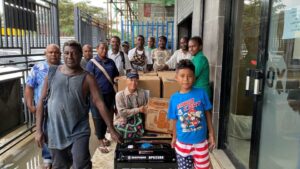BY JOHN CHRISMA
THE famous Mamara spring in North-West Guadalcanal has served the rural communities with plentiful clean and drinkable water for personal and domestic uses.
The majority of the rural population residing on LDA and Borosugu village, which is closer to the Mamara springs often fulfill their water demands by collecting water in containers from the spring.
In such areas it is not difficult to find aquifers of clean water that often manifest themselves in the form of springs, easily spotted while walking in the nearby bushes or inland forest areas.
Springs of clean water found in the tropical bush areas are always a blessing for the communities in this region of Guadalcanal province.
Maxon Oliver, a resident of the Borosugu community, told Environment Media that they have been managing well the Mamara spring water for their household chores, and drinking.
“There have been many changes to our environment over the years due to human development. One of these changes is Mamara New Capital City Development.
“Our major concern is the risk posed by the development on our rural livelihood. Our community’s most basic livelihood comes from the Mamara Springs, for example, Mamara Springs is our only water source, which we had to travel several kilometres to fetch water.
“All settlers and nearby communities often fetch drinkable water from the Mamara using containers,” Oliver said.
Meanwhile, Watercress – is one crop that earns a lot of income for the nearby communities or households involved in growing it.
As watercress grows only in damp and moist places and even on water, the Mamara Springs has been utilized commonly for this. They use a technic which is like anchored rafts where lines of beds are built on the water using floatable material such as bamboo. Tiny cresses and most importantly their roots are held on these beds. Their roots spread quickly and eventually newer suits sprout and over time the beds become filled with this salad crop. Watercress beds can be found in the upper section of the springs towards the source spring.
The Mamara Springs itself is more than a kilometer to the spring from its mouth. Watercress is produced at around 50 to 100 parcels during each harvest and sold at $10 a parcel. Each parcel is estimated at around 200-300 grams. So, for each harvest, this equates to some total weight of around 10kg to 30kg which makes for an overall income of $500 to $1000 per harvest




